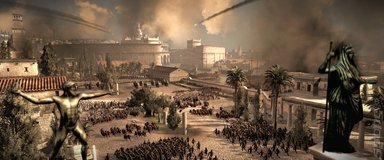Creative Assembly had a lot to shout about at Gamescom last week, after its exciting reveal of long-awaited RTS sequel Total War: Rome II.
Al Bickham is the studio communications manager for the studio, and I managed to have a sit down with him to discuss the nature of the live-action trailer, CA's work in the mobile field and whether we'll see a browser future for the classic strategy series.
SPOnG: You guys announced this title by releasing a live action trailer. Itís a different kind of tack for Creative Assembly to take, isnít it? Are you going for a much more dramatic angle here?
Al Bickham: Well, I think that live action trailer is a statement of intent. Youíve got three story threads running in that action trailer, that relates to machinations in the senate, betrayal and division between families. It's these kinds of story elements that Total War is best known for. Itís about emergent stories. Youíre making a massive series of choices about which territories youíre capturing and where to put the bulk of your forces, and interesting things naturally fall out of that.
But for Rome II, weíre expanding the Dilemmas feature that we introduced in Shogun 2. These were little quests that would appear that, if you chose to acknowledge them, could benefit you at an appropriate cost. Youíd get great power, but also a significant downside. Weíre extending that system and offer you multiple paths depending on the choices you make during key decisions. That trailer is essentially a representation of those archetypal Roman storylines that weíre working into the game.
SPOnG: Development on Rome II started while you were working on Shogun 2, right?
AB: Yeah, well actually towards the end of Fall of the Samurai expansion pack.
SPOnG: So what kind of things did you learn from Shogun 2, that you carried over to Rome II?
AB: A tonne of stuff. Shogun 2 could be seen, in retrospect, as an exercise. We came out of making Empire, which was a massive, sprawling, enormous game, and decided to focus a bit with the Napoleon expansion pack. When we got to Shogun 2, everything was about focus. Tight geographical focus, sure, but also a focus on polishing in-game systems that we recently introduced.
After learning a lot from that, we revamped the system again for Rome II, in terms of how the campaign AI approaches diplomacy, the way you interact with it and the understanding of the AIís actions. That was one thing we wanted to change - the AI made a decision, and you werenít necessarily given any visibility as to why itís done that. We want to offer some visual cues to aid that process. If the AI seemingly stabs you in the back, and youíre given some vague understanding as to why, youíre less likely to say that itís being completely arbitrary. Itís all early stuff, but thatís what weíre trying to work out.
SPOnG: So youíve made it more accessible.
AB: Thatís the aim. Iím gonna be deliberately vague about it now, because weíre still working on that part of the game, and exactly how itís going to pan out in the final version. But yeah, so thereís certain things like that weíre working on - but besides that we also learned a lot of things from Shogun 2 in terms of how the battlefield works, the unit movements and swordfighting styles and things like that.
For Rome II, weíre quite happy with where the game systems are, so nowís the time to roll the map out wider. The campaign map for Rome II is going to be much bigger than the original Rome. And that was huge. Thereís a number of interesting problems that this throws up, though. How do you manage that many territories, for example? Strategy games are about giving the user lots of interesting decisions to make, but they shouldnít be about giving the player the same decision to make from turn to turn. So you can imagine that with the amount of territory and regions on offer, you are at risk of overburdening the player with micro-management.
SPOnG: How do you combat that sort of thing, then?
AB: One of our aims is to create a province system. Before, in something like Empire, you could capture France by simply storming the capital. Thatís not the kind of thing weíre aiming for. So in Rome II each province will contain a number of smaller territories, but there will be province capitals that can give you control of multiple territories at once. This way, you still get the tactical and strategic depth of having more land to conquer, but youíre not controlling each and every section of a country by the end of the game.
SPOnG: Creative Assembly jumped on board with iOS development with Total War Battles: Shogun. You mentioned making Rome II a bit more accessible - did the iOS philosophy come into your PC design approach at all?
AB: No, the teams work fairly separately. I think thatís important from a design perspective, because the tenets of device like an iPad... obviously, itís much more than just the input functions. You have to consider shorter play times, the ability to switch the game off and on again, and so on. Whereas with classic Total War, youíre sat at your PC and you may play for two or three hours at a time. Itís a very different experience.
So thereís not an enormous amount of cross-pollination between those teams. One thing that does pass across is stuff like animation. The combat animations [in Total War Battles] are quite detailed, and the audio mirrors whatís in Shogun. There are similar sword strike noises, music, etc. Of course, on the design front, itís very different again - very stylised and arty. Everyoneís quite proud of it.



